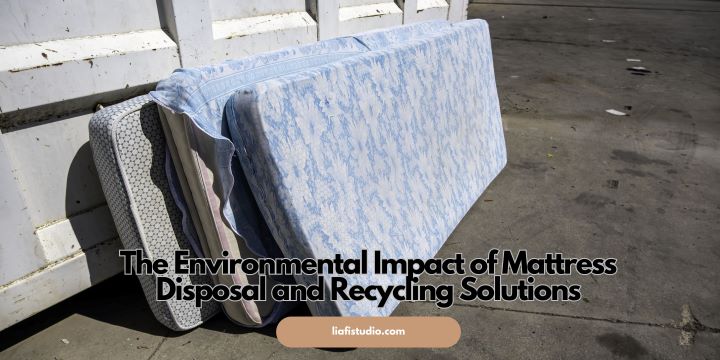Key Takeaways:
- The significant environmental impact of improperly disposed mattresses.
- Various eco-friendly options are available for mattress disposal.
- Emerging trends in sustainable mattress production and recycling.
Knowing how complicated mattress disposal is will help you make wise judgments when it’s time to get rid of an old bed. On the face of it, disposing of an unwanted mattress by simply throwing it out is the easiest option. However, the environmental repercussions of such actions are far-reaching and contribute to ongoing sustainability challenges. The importance of practicing responsible mattress removal becomes apparent when considering how our individual choices can accumulate and impact landfill waste, posing threats to the environment and human health.
Understanding Mattress Waste
Every year, countless mattresses are disposed of, often with little consideration for their environmental impact. The issue of mattress waste is particularly challenging due to the large quantities and diverse materials involved. These voluminous items occupy significant landfill space and do not break down naturally. The decomposition process of mattresses’ metal, foam, and fabric constituents can span decades, releasing harmful substances into the soil and water. Compelling data underscores that a single mattress can occupy up to 40 cubic feet of landfill space, magnifying the spatial challenge. Addressing mattress removal is crucial in mitigating this environmental burden.
This is not to mention the broader environmental concerns, such as the increase in greenhouse gases and chemical leaching, making the need for sustainable mattress waste management practices more critical than ever.
The Journey of a Discarded Mattress
Imagine the path a mattress takes from the moment it is discarded. It’s often hauled off to the nearest landfill, becoming one more item in a towering pile of waste. There it lies, potentially for generations, occupying space and contributing to the mounting pressure on our waste management systems. Mattresses pose particular issues for garbage facilities because of their size and construction components. They can’t be easily compressed like other waste materials, occupying a disproportionate amount of space. Furthermore, the elements of a mattress, such as metal springs and polyurethane foam, can be hazardous if not managed properly, degrading into chemicals harmful to the environment and human health. As mattresses decompose, they also risk becoming harborages for pests and microorganisms, fuelling health hazards that extend far beyond the confines of landfill sites.
Eco-Friendly Disposal Options
In light of these challenges, identifying eco-friendly disposal options becomes paramount. Luckily, sustainable alternatives exist and are becoming more accessible. For instance, a mattress may frequently be disassembled so that its metal, wood, and fibers can be recycled or used for other purposes when it is no longer fit due to wear and tear. This diversion from landfills conserves valuable resources and decreases waste. Organizations and services have sprung up in recent years to facilitate this eco-friendly approach, offering consumers ways to dispose of their mattresses responsibly. Recycling Programs Aim to Reduce Mattress Waste illustrates how these programs reduce environmental impact and foster a sense of community responsibility towards tackling mattress disposal.
The Benefits of Mattress Recycling
One of the most compelling approaches to managing mattress waste is recycling. The benefits extend well beyond the environmental sphere—recycling programs can offer economic advantages, too. These programs are often part of a larger circular economy, where materials from old mattresses are retrieved and used to create new products. This process conserves raw materials and reduces the need for additional manufacturing, ultimately lowering carbon footprints. Additionally, mattress recycling helps to create new job opportunities within the growing green job sector, supporting local economies. Stories of successful recycling initiatives remind us that sustainable practices can be both environmentally beneficial and economically viable.
Innovative Materials in Mattress Manufacturing
The mattress industry is not blind to end-of-life disposal issues and has been investing in innovation to reduce its environmental footprint. Hence, we’re witnessing an exciting era where manufacturers explore biodegradable and recyclable materials in their products. A recent surge in plant-based foams, organic fibers, and even upcycled materials represents a monumental shift toward sustainable bedding. The Rise of Sustainable and Eco-Friendly Bedding Solutions captures the essence of these advancements. It underscores the growing demand from consumers eager to align their purchase habits with their environmental values.
Global Perspectives on Mattress Disposal
The strategies employed to combat the problem of mattress disposal differ significantly worldwide. In some countries, strict regulations have been imposed to ensure that mattresses are correctly recycled. The infrastructure may still need to be established to support such processes, resulting in continued dependency on traditional waste management strategies. Interestingly, we can learn much from the various international policies and practices. These diverse worldwide viewpoints offer insightful information about how we may keep innovating and improving mattress waste management, ensuring that best practices may be implemented and tailored to local circumstances.
Personal Responsibility and Consumer Action
While broader initiatives are essential, the responsibility for sustainable mattress disposal also lies with individual consumers. Simple actions like using a mattress protector can prolong a mattress’s life and reduce the turnover rate. When a mattress has reached the end of its life, consumers should consider environmentally responsible options, such as donating to charity or recycling. Donations can give a mattress a second life and serve a significant need, provided it is still usable. By being proactive and seeking out appropriate disposal or recycling services, consumers play a critical role in closing the loop of the mattress lifecycle.
Policy and Regulation Impact
Effective policy and regulation can dramatically alter the landscape of mattress disposal. Manufacturers and retailers must consider their products’ end-of-life impact in regions where such policies have been implemented. Extended producer responsibility (EPR) laws have been enacted in several jurisdictions, which hold manufacturers responsible for the post-consumer portion of their products’ lives. These regulations encourage the production of more sustainable mattresses and promote the development of recycling and reuse programs to help alleviate the pressure on landfills.
The Future of Sustainable Sleep
The sleep industry is on the cusp of a sustainability revolution. The market for green sleep solutions is projected to grow as more customers become conscious of how their purchases affect the environment. Anticipating this shift, forward-thinking companies are already developing more accessible mattresses to recycle or incorporate bio-based materials. These innovations are paving the way for a future where mattresses are not just comfortable but also contribute to the health of our planet. Foreseeing this trend, stakeholders are investing in processes and technologies that will further streamline mattress recycling, making sustainable sleep a realizable dream.
Taking Action: How You Can Help
Our approach to mattress disposal requires a systematic overhaul. Each participant in the lifecycle of a mattress—from manufacturers to consumers—has an opportunity to contribute to a solution. We can incite change by shifting to eco-friendly mattresses, supporting recyclable product design, and advocating for responsible disposal options. The key is to remain informed, stay proactive, and take tangible steps toward fostering a more sustainable system. When looking to replace a mattress, consumers can look for green certifications, evaluate product materials, and choose retailers that offer take-back or recycling programs. By prioritizing sustainability over convenience, we can all engage in the collective action needed to address the significant issues posed by mattress waste.




